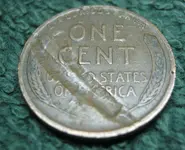Due to the pressure of striking, the metal becomes more dense when the coin is struck and things like lettering, date, mint mark and details are kind of like super embedded into the metal (kind of like the metal is stacked from the surface to well below the surface). As layer upon layer of the coin is peeled away, evidence of the lettering and details will still be found nearly a third away down into the surface of the coin. At the same time, the lettering, date, mint mark or details inside a lamination peel, can be enhanced due to the metal where the fields (flat portions of the coin with no lettering, date, mint mark and details) are on a coin, being much denser and allowing the less dense lettering, date, mint mark or details to be visible. Sorry if this is confusing but it is just as confusing to try to explain it!
On Buffalo Nickels, many folks use Nick-A-Date to restore a Date and sometimes a Mint mark. This is possible due different densities of the metal and the acid eating the metal around the date away. For a long time, I used to think that the metal on and under the lettering, date, mint mark and details was denser than the metal under the fields but that is not case and is the exact opposite.
Frank


